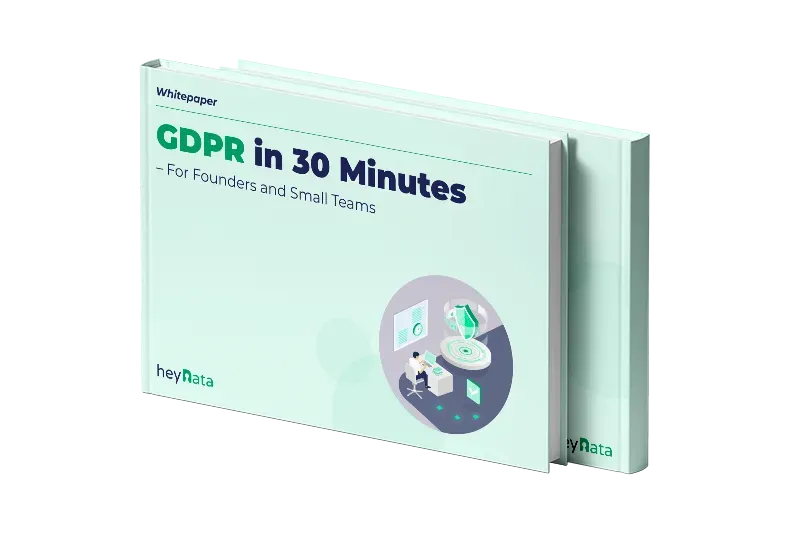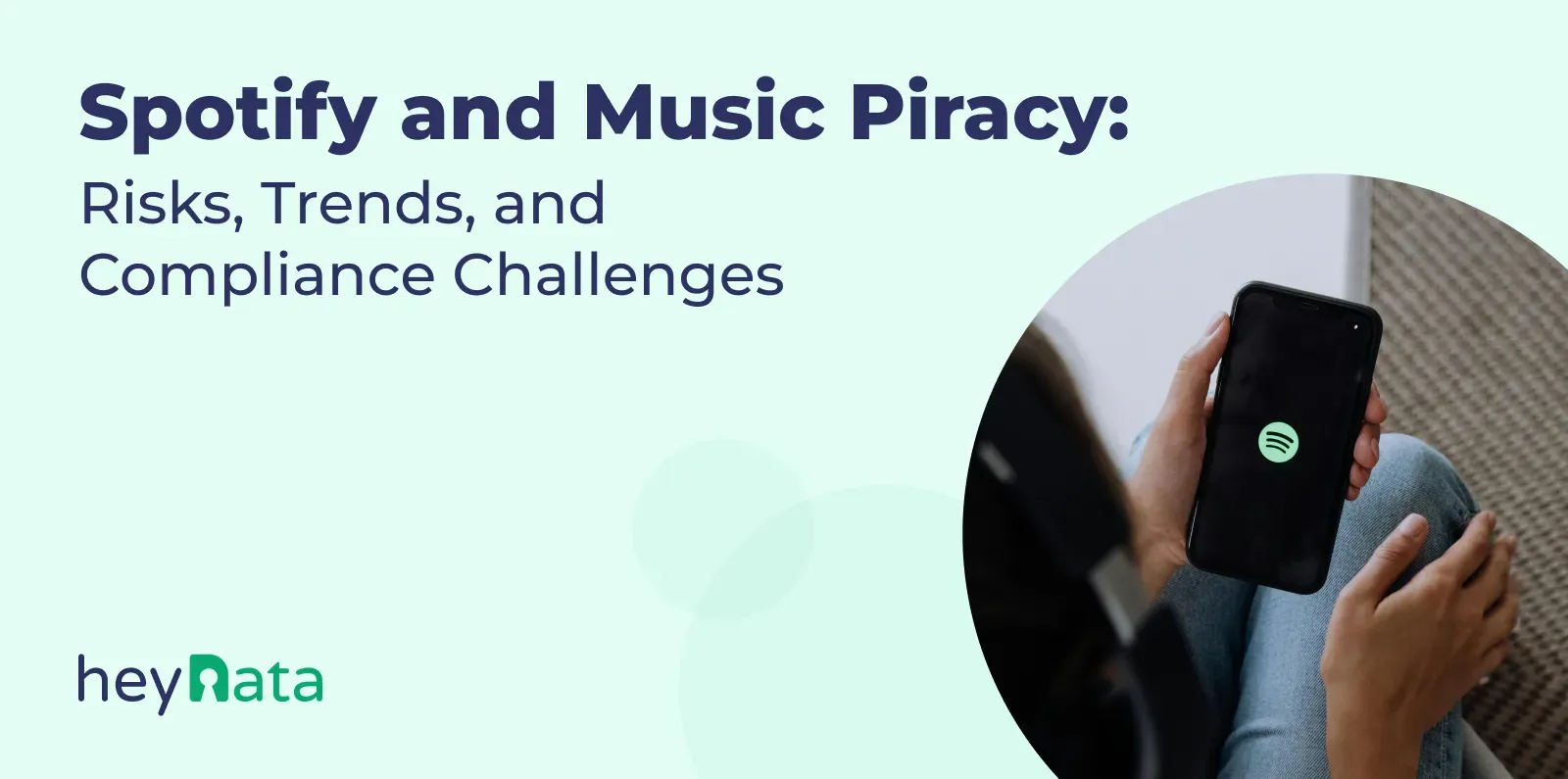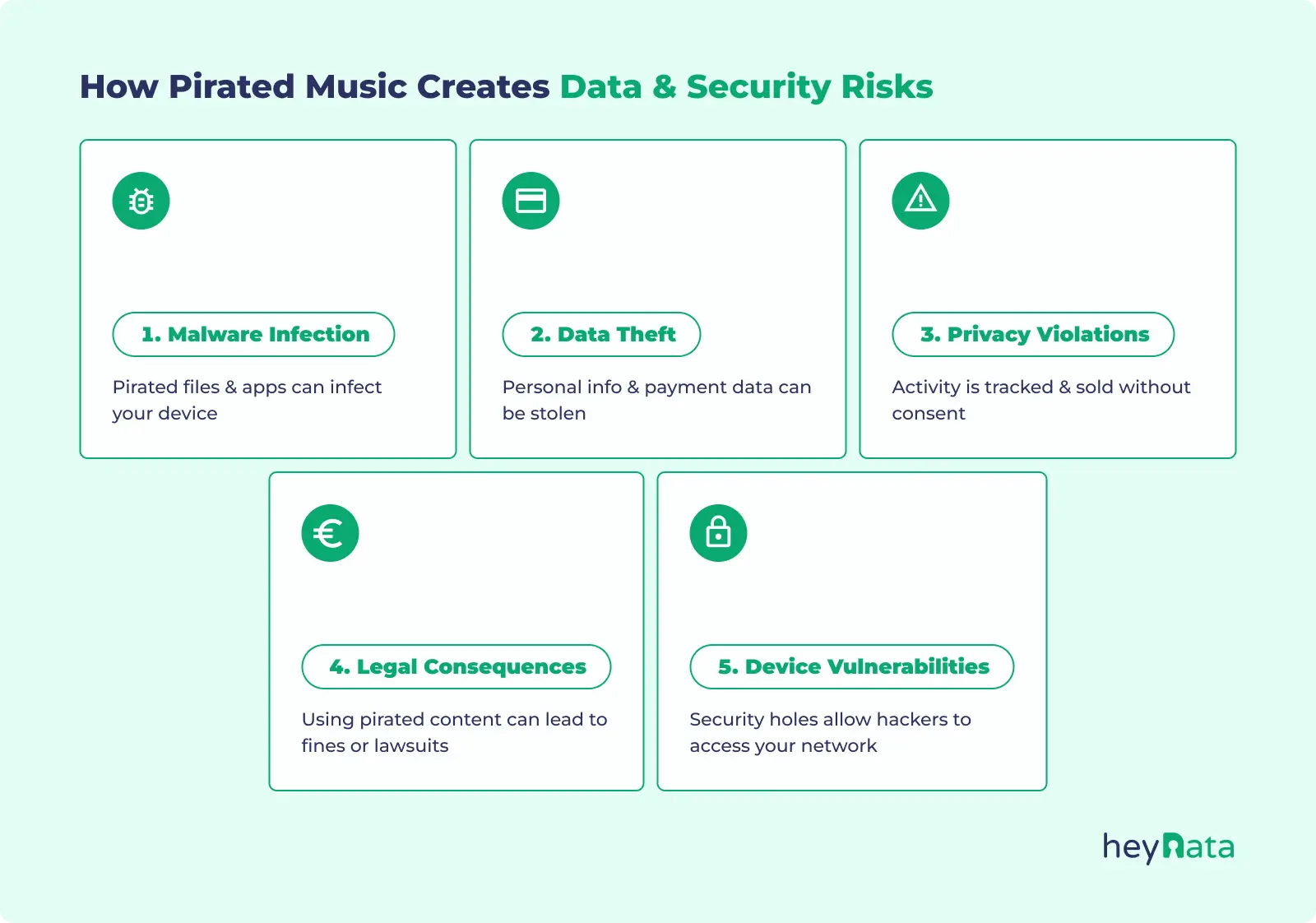
Understand GDPR in only 30 minutes!

Spotify and Music Piracy: Risks, Trends, and Compliance Challenges

'%3e%3cpath%20d='M26.6667%2020.022L30%2023.3553V26.6886H21.6667V36.6886L20%2038.3553L18.3333%2036.6886V26.6886H10V23.3553L13.3333%2020.022V8.35531H11.6667V5.02197H28.3333V8.35531H26.6667V20.022Z'%20fill='%230AA971'/%3e%3c/g%3e%3c/svg%3e) Key Points at a Glance
Key Points at a Glance
- Spotify faces ongoing challenges with illegal downloads and copyright violations
- Rising subscription prices can drive users toward piracy
- Privacy and copyright compliance are often in tension
- Companies and compliance officers need to understand the risks
- Anti-piracy strategies include technical measures, pricing, and education
Spotify is one of the leading music streaming services worldwide. At the same time, music piracy and illegal downloads remain a major problem. Piracy not only threatens the music industry but also exposes users to privacy and security risks. In this article, we’ll explore the connection between Spotify and music piracy, the factors that drive users toward illegal downloads, and practical measures companies can take to mitigate these risks.
Table of Contents:
What Music Piracy Means in the Spotify Context
Music piracy related to Spotify includes the use of illegal platforms to stream or download music without paying for it. Key forms include:
- Illegal streaming websites: Sites offering free access to songs, often containing malware
- Pirated downloads: Users download MP3 files, bypassing licensing fees
- Modified Spotify clients: Apps unlocking premium features without subscription
Why Piracy Persists Despite Spotify
Even though Spotify offers affordable plans, several factors drive users toward piracy:
- Rising subscription costs: Higher prices push budget-conscious users to illegal alternatives
- Geographic restrictions: Some songs are not available in all countries
- Unlimited offline access: Users want complete control over downloads
- Anonymity: Illegal platforms require no registration or payment information
According to Statista, while Spotify subscriptions grow, piracy remains prevalent.
Risks of Music Piracy for Companies and Users
For Companies
- Revenue loss: Artists and labels lose income
- Reputational damage: Brands can be associated with illegal platforms
- Compliance risks: Facilitating piracy can create legal liabilities
For Users
- Malware and security threats: Pirated downloads often contain viruses
- Privacy breaches: Personal or payment data may be stolen
- Legal consequences: Illegal streaming can be punishable by law

Understand GDPR in only 30 minutes!
Legal Considerations
In Germany, copyright is governed by the Urheberrechtsgesetz (UrhG). Key points for users and companies:
- Downloading or distributing copyrighted music without a license is illegal (§ 106 UrhG)
- Violations can result in fines or civil claims
- Companies should include a disclaimer: this article provides general information, not legal advice
Note: To stay legally safe, only use licensed content.
Case Study: Streaming Services Driving Users Back to Piracy
According to a The Guardian article (August 14, 2025), rising subscription costs and fragmented streaming offerings are pushing users back to piracy. In Sweden, for example, 25% of respondents reported illegally downloading content in 2024, particularly among users aged 15–24. This trend is linked to higher subscription prices, geographic restrictions, and fragmented content availability.

Technical Measures Against Music Piracy
Spotify and the music industry employ multiple strategies to fight piracy:
Measure | Description |
| Digital Rights Management (DRM) | Protects content through encryption |
| Licensing monitoring | Tracks illegal distribution of songs |
| User-friendly pricing | Makes piracy less attractive |
| Awareness campaigns | Educates users about the risks of illegal downloads |
Real-World Examples
- Spotify Premium hacks: Modified APKs allow free premium access but risk malware and data theft
- Illegal streaming platforms: Sites like MP3Skull or 1337x offer copyrighted music, endangering users and artists
FAQs
Is Spotify secure against piracy?
Spotify itself is secure, but modified apps and illegal sites pose risks to users.
Can companies prevent piracy completely?
No, but DRM, awareness campaigns, and fair pricing can reduce it.
Are there legal consequences for piracy?
Yes, both operators of illegal platforms and users can face legal action.
Why does piracy persist despite Spotify?
Higher subscription fees, geographic restrictions, and the desire for unlimited offline access drive users to piracy.
How can users protect themselves?
Use only official apps, choose premium or legal alternatives, and avoid unknown downloads.
Conclusion
Spotify and music piracy are closely linked. Pricing, availability, and user behavior influence the prevalence of piracy. For companies, CTOs, CEOs, and compliance officers, understanding risks, implementing technical and legal measures, and educating users is crucial. This balance ensures legal music consumption while maintaining compliance and security.
Important: The content of this article is for informational purposes only and does not constitute legal advice. The information provided here is no substitute for personalized legal advice from a data protection officer or an attorney. We do not guarantee that the information provided is up to date, complete, or accurate. Any actions taken on the basis of the information contained in this article are at your own risk. We recommend that you always consult a data protection officer or an attorney with any legal questions or problems.


